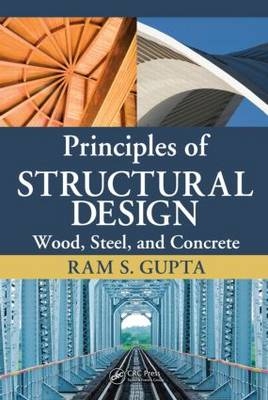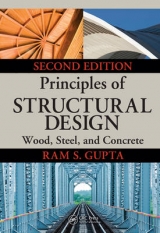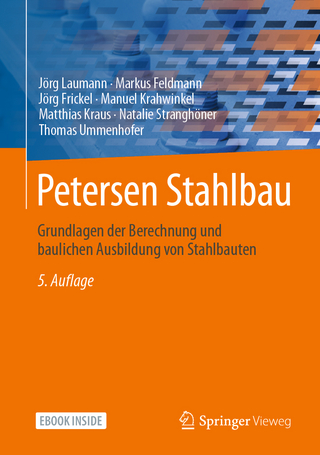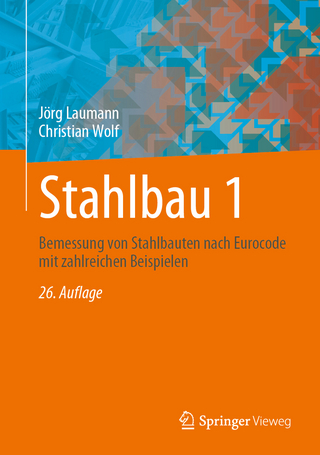
Principles of Structural Design
Crc Press Inc (Verlag)
978-1-4200-7339-3 (ISBN)
- Titel erscheint in neuer Auflage
- Artikel merken
Anyone involved with structural design, whether a student or a practicing engineer, must maintain a functional understanding of wood, steel, and concrete design principles. In covering all of these materials, Principles of Structural Design: Wood, Steel, and Concrete fills a gap that exists in the instructional resources. It provides a self-contained authoritative source that elaborates on the most recent practices together with the code-connected fundamentals that other books often take for granted.
Dr. Ram Gupta, a professional engineer, provides readers with insights garnered over a highly active 40-year international career. Organized for ready reference, the book is divided into four main sections.
Part I covers loads, load combinations, and specific code requirements for different types of loads. It elaborates on the LRFD (load resistance factor design) philosophy and the unified approach to design.
Part II covers sawn lumber, structural glued laminated timber, and structural composite lumber. It reviews tension, compression, and bending members, as well as the effects of column and beam stabilities and combined forces.
Part III considers the steel design of individual tension, compression, and bending members. Additionally, it provides designs for braced and unbraced frames. Open-web steel joists and joist girders are included here as they form a common type of flooring system for steel-frame buildings.
Part IV analyzes the design of reinforced beams and slabs, shear and torsion, compression and combined compression, and flexure in relation to basic concrete structures.
This textbook presents the LRFD approach for designing structural elements according to the latest codes. Written for architecture and construction management majors, it is equally suitable for civil and structural engineers.
Ram S. Gupta holds a master of engineering degree from IIT, Roorkee, India, and a PhD from Polytechnic University, New York. He is a registered professional engineer in Rhode Island and Massachusetts. Dr. Gupta has 40 years of experience working on projects in the United States, Australia, India, and Liberia (West Africa), and is currently working as a professor of engineering at Roger Williams University (RWU), Bristol, Rhode Island. He has been a full-time faculty member at RWU since 1981. He was a rotary scholar professor at Kathmandu University, Dhulikhel, Nepal, and a Fulbright scholar at the Indian Institute of Technology, Kanpur, India. Dr. Gupta is president of Delta Engineers, Inc., an Rhode Island-based consulting company, specializing in structural and water resource disciplines. Besides contributing to a very large number of research papers, he has authored two very successful books: Hydrology and Hydraulic Systems, 3rd edition (Waveland Press, Long Grove, IL, 2008), Introduction to Environmental Engineering and Science, 2nd edition (ABS Consulting, Rockville, MD, 2004), and Principles of Structural Design: Wood, Steel, and Concrete (Taylor & Francis, Boca Raton, FL, 2010).
DESIGN LOADS
Design Criteria
Classification of Buildings
Building Codes
Standard Unit Loads
Tributary Area
Working Stress Design, Strength Design, and Unified Design of Structures
Elastic and Plastic Designs
Elastic Moment Capacity
Plastic Moment Capacity
The Combination of Loads
Problems
Primary Loads: Dead Loads and Live Loads
Dead Loads
Live Loads
Floor Live Loads
Basic Design Live Load, Lo
Effective Area Reduction Factor
Other Provisions for Floor Live Loads
Roof Live Loads, Lr
Tributary Area Reduction Factor, R1
Slope Reduction Factor
Problems
Snow Loads
Introduction
Balanced Snow Load
Importance Factor
Thermal Factor, Ct
Exposure Factor, Ce
Roof Slope Factor, Cs
Rain-on-Snow Surcharge
Partial Loading of the Balanced Snow Load
Unbalanced Snow Load due to Drift
Across the Ridge Snow Drift on a Roof
Snow Drift from a Higher to a Lower Roof
Leeward Snow Drift
Windward Snow Drift
Sliding Snow Load on Lower Roof
Problems
Wind Loads
Introduction
The Simplified Procedure for MWFRS
Horizontal Pressure Zones for MWFRS
Vertical Pressure Zones for MWFRS
Minimum Pressure for MWFRS
The Simplified Procedures for Components and Cladding
Minimum Pressures for Components and Cladding
Problems
Earthquake Loads
Seismic Forces
Seismic Parameters
Fundamental Period of Structure
Ground Spectral Response Maps
Adjusted Spectral Response Accelerations
Design Spectral Acceleration
Design Response Spectrum
Importance Factor, I
Seismic Design Categories
Exemptions from Seismic Designs
Equivalent Lateral Force Procedure to Determine Seismic Force
Effective Weight of Structure, W
Seismic Response Coefficient, Cs
Response Modification Factor, R
Distribution of Seismic Forces
Distribution of Seismic Forces on Vertical Wall Elements
Distribution of Seismic Forces on Horizontal Elements (Diaphragms)
Design Earthquake Load
Problems
WOOD STRUCTURES
Wood Specifications
Engineering Properties of Sawn Lumber
Reference Design Values for Sawn Lumber
Adjustments to the Reference Design Values for Sawn Lumber
Time Effect Factor, λ
Size Factor, CF
Size Factor, CF for Dimension Lumber
Size Factor, CF for Timber
Repetitive Member Factor, Cr
Format Conversion Factor, KF
Resistance Factor,
LRFD Design with Wood
Structural Glued Laminated Timber
Reference Design Values for GLULAM
Adjustment Factors for GLULAM
Flat Use Factor for GLULAM, Cfu
Volume Factor for GLULAM, Cv
Curvature Factor for GLULAM, Cc
Structural Composite Lumber
Problems
Flexure and Axially Loaded Wood Structures
Introduction
Design of Beams
Bending Criteria of Design
Beam Stability Factor, CL
Effective Unbraced Length
Shear Criteria
Deflection Criteria
Bearing at Supports
Bearing Area Factor, Cb
Design of Axial Tension Members
Design of Columns
Column Stability Factor, CP
Design for Combined Bending and Compression
Problems
Wood Connections
Types of Connections and Fasteners
Dowel-Type Fasteners (Nails, Screws, Bolts, Pins)
Yield Limit Theory for Laterally Loaded Fasteners
Yield Mechanisms and Yield Limit Equations
Reference Design Values for Lateral Loads (Shear Connections)
Reference Design Values for Withdrawal Loads
Adjustments of the Reference Design Values
Wet Service Factor, CM
Temperature Factor, Ct
Group Action Factor, Cg
Geometry Factor, CΔ
End Grain Factor, Ceg
Diaphragm Factor, Cdi
Toenail Factor, Ctn
Nail and Screw Connections
Nails
Wood Screws
Bolt and Lag Screw Connections
Bolts
Lag Screws
Problems
STEEL STRUCTURES
Tension Steel Members
Properties of Steel
The 2005 Unified Design Specifications
Limit States of Design
Design of Tension Members
Tensile Strength of Elements
Net Area, An
Shear Lag Factor for Unattached Elements
Block Shear Strength
Design Procedure for Tension Members
Problems
Compression Steel Members
Strength of Compression Members or Columns
Local Buckling Criteria
Flexural Buckling Criteria
Effective Length Factor for Slenderness Ratio
Limit States for Compressive Strength
Non-Slender Members
Flexural Buckling of Non-Slender Members in Elastic and Inelastic Regions 6
Inelastic Buckling
Elastic Buckling
Torsional and FlexuralTorsional Buckling of Non-Slender Members
Slender Compression Members
Use of the Compression Tables
Problems
Flexural Steel Members
The Basis of Design
Nominal Strength of Steel in Flexure
Lateral Unsupported Length
Fully Plastic Zone with Adequate Lateral Support
Inelastic Lateral Torsional Buckling (I-LTB) Zone
Elastic Lateral Torsional Buckling (E-LTB) Zone
Slender Beam Sections
Compact Full Plastic Limit
Noncompact Flange Local Buckling (N-FLB)
Slender Flange Local Buckling (S-FLB)
Summary of Beam Relations
Design Aids
Shear Strength of Steel
Beam Deflection Limitations
Problems
Combined Forces on Steel Members
Design Approach to the Combined Forces
Combination of Tensile and Flexure Forces
Combination of Compression and Flexure Forces: The Beam-Column
Members
Members without Sidesway
Members with Sidesway
Magnification Factor, B1
Moment Modification Factor, Cm
Braced Frame Design
Magnification Factor for Sway, B2
Unbraced Frame Design
Open-Web Steel Joists
Joist Girders
Problems
Steel Connections
Types of Connections and Joints
Bolted Connections
Specifications for Spacing of Bolts and Edge Distance
Bearing-Type Connections
Slip-Critical Connections
Tensile Load on Bolts
Combined Shear and Tensile Forces on Bolts
Combined Shear and Tension on Bearing-Type Connections
Combined Shear and Tension on Slip-Critical Connections
Welded Connections
Fillet Welds
Effective Area of Weld
Minimum Size of Weld
Maximum Size of Weld
Length of Weld
Strength of Weld
Complete Joint Penetration (CJP) Groove Welds
Partial Joint Penetration (PJP) Welds and Fillet Welds
Frame Connections
Shear or Simple Connection for Frames
Single-Plate Shear Connection or Shear Tab
Framed-Beam Connection
Seated-Beam Connection
End-Plate Connection
Single-Plate Shear Connection for Frames
Moment-Resisting Connection for Frames
Problems
REINFORCED CONCRETE STRUCTURES
Flexural Reinforced Concrete Members
Properties of Reinforced Concrete
Compression Strength of Concrete
Design Strength of Concrete
Strength of Reinforcing Steel
LRFD Basis of Concrete Design
Reinforced Concrete Beams
Derivation of the Beam Relations
The Strain Diagram and Modes of Failure
Balanced and Recommended Steel Percentages
Minimum Percentage of Steel
Strength Reduction Factor for Concrete
Specifications for Beams
Analysis of Beams
Design of Beams
Design for Reinforcement Only
Design of Beam Section and Reinforcement
One-Way Slab
Specifications for Slabs
Analysis of One-Way Slab
Design of One-Way Slab
Problems
Shear and Torsion in Reinforced Concrete
Stress Distribution in Beam
Diagonal Cracking of Concrete
Strength of Web (Shear) Reinforced Beam
Shear Contribution of Concrete
Shear Contribution of Web Reinforcement
Specifications for Web (Shear) Reinforcement
Analysis for Shear Capacity
Design for Shear Capacity
Torsion in Concrete
Provision for Torsional Reinforcement
Problems
Compression and Combined Forces Reinforced Concrete Members
Types of Columns
Pedestals
Columns with Axial Loads
Short Columns with Combined Loads
Large or Slender Columns with Combined Loads
Axially Loaded Columns
Strength of Spirals
Specifications for Columns
Analysis of Axially Loaded Columns
Design of Axially Loaded Columns
Short Columns with Combined Loads
Effects of Moment on Short Columns
Only Axial Load Acting (Case 1)
Large Axial Load and Small Moment (Small Eccentricity) (Case 2)
Large Axial Load and Moment Larger Than Case 2 Section (Case 3)
Large Axial Load and Moment Larger Than Case 3 Section (Case 4)
Balanced Axial Load and Moment (Case 5)
Small Axial Load and Large Moment (Case 6)
No Appreciable Axial Load and Large Moment (Case 7)
Characteristics of the Interaction Diagram
Application of the Interaction Diagram
Analysis of Short Columns for Combined Loading
Design of Short Columns for Combined Loading
Long or Slender Columns
Problems
Appendix A: General
Appendix B: Wood
Appendix C: Steel
Appendix D: Concrete
References and Bibliography
Index
| Erscheint lt. Verlag | 6.8.2010 |
|---|---|
| Zusatzinfo | approx 250 equations; 157 Tables, black and white; 381 Illustrations, black and white |
| Verlagsort | Bosa Roca |
| Sprache | englisch |
| Maße | 174 x 246 mm |
| Gewicht | 1021 g |
| Themenwelt | Technik ► Bauwesen |
| ISBN-10 | 1-4200-7339-7 / 1420073397 |
| ISBN-13 | 978-1-4200-7339-3 / 9781420073393 |
| Zustand | Neuware |
| Haben Sie eine Frage zum Produkt? |
aus dem Bereich



